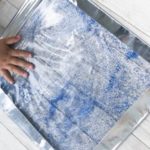This is a really simple activity that will keep baby mesmerized for days and is perfect for Halloween! This is a mess-free activity, that you can take any where, tape it to a sunny window, or just give it to your baby so they can explore with their hands. We have tried this at our CEFA Early Learning schools in our CEFA baby and JK1 classrooms and it inevitably draws the older siblings when they come and visit. Try it at home and let me know how much your baby likes it.
If you are worried about it opening, use duct tape to reinforce all 4 sides of the bag once it is sealed closed. But as you know, no young child should be left unattended, especially not around bags and small items. Always supervise.
Best Ages for This Activity
One to three
How to Make It
Ingredients
- A medium Ziploc freezer bag. You can make it a large one if you prefer and double the rest of the ingredients. You can even use an extra large one and encourage baby to explore with their hands and feet!
- 1 jar of inexpensive hair gel. You can find this at the dollar store also.
- Duct tape for all 4 sides of the bag. We will be making many different many different sensory bags in the future, so keep the roll!
- Googly eyes of various sizes. Again, keep these as we will be using for many other activities!
- Food colouring of your favourite colour to make the gel intensely colourful! You will notice that the food colouring I specified is a little more expensive as I use it for many other activities and it blends really well, but you can use any food colouring you already have around the house!
Let’s Get Started!
- To make the sensory bag, first open the freezer bag, pour the hair gel inside it and add a few drops of food colouring, Mix well, then add the googly eyes. Add enough to give your child different textures and sizes to explore.
- Squeeze as much air as possible out of the bag before sealing. Once sealed, use the duct tape to tape around all 4 sides of the bag:

- Decide where you want to leave the bag. At our CEFA Early Learning schools, we normally tape them to a glass window at child height (sitting or standing) first and after a week, we leave them on the floor (taped) for a week so they can play with them from a different angle, plus use their feet, then leave them around, loose, for children to manipulate in a different way and carry them around. One bag can last you a whole month and still provide different options to explore it! You can also take it with you in a stroller, or in the car. You can hide it in a basket, or under a shelf, for your child to find!
- You don’t even need to invite your child to play with the bag, they will find it on their own and be immediately drawn to it. If you used duct tape, don’t be afraid to let your child manipulate the bag with vigor – it will withstand a little tough love. Just make sure you can supervise in case it punctures.
- Questions you can ask:
- What does it feel like? – this will help them build vocabulary, which is necessary for literacy skills. Use words like slippery, squishy, smooth, bumpy, etc.
- How many eyes can you count? What colours are they? How many of each colour? What size are the eyes? How many large eyes? How many medium eyes? How many small eyes? This will help them gain math vocabulary as well as learn to count, estimate and compare (also essential math skills).
- What happens when you squish the bag? (S.T.E.M., cause and effect, observation, reasoning)
Learning Opportunities
Sensory bags are a good way of providing a sensory exploration activity for your child which does not make a mess. They can be taped to the floor, to a window and taken in the car or anywhere you have to be patient and wait (for example, a waiting room). Your child can use their imagination, play and use their senses, especially the sense of touch and sight.
Sensory play is important to expand your child’s language skills, therefore developing literacy skills. They also develop sensory input and fine motor skills in young children especially. Research has also shown that sensory bags decrease restlessness and stress in children and help your child learn to be in the moment (mindfulness). These sensory bags are especially beneficial for young babies as well as for children who suffer from ADHD and sensory processing disorder (SPD). You can fill sensory bags with objects that provide different textures, colours and sounds (just be mindful not to choose items that can puncture your bag). They are excellent for babies during tummy time! Sensory bags also provide S.T.E.M. learning as your child learns to estimate, observe, experience cause and effect, etc. Make sure you use as much math vocabulary as you can (for example, estimate, talk about sizes, measure the intensity of the colours, the different colours, etc.)
CEFA Tip: Remember to always supervise your child.
As an Amazon Associate I earn from qualifying purchases